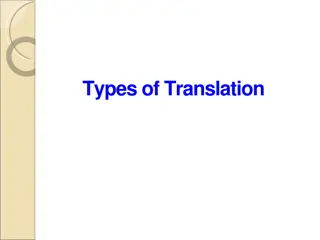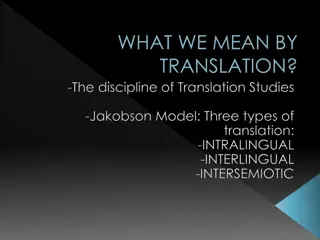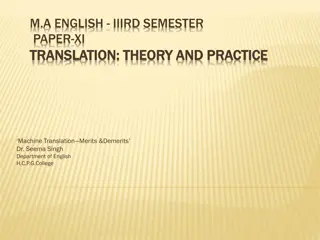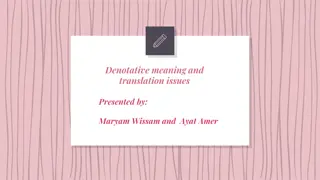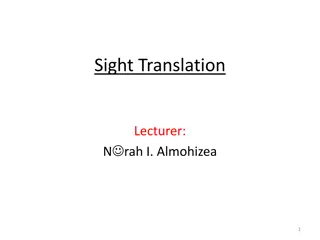Understanding Connotative Meaning and Translation Issues
Exploring the complexities of connotative meaning within texts, this article discusses the various types of connotative meanings and the challenges they pose for translation. It delves into attitudinal, associative, and affective meanings, emphasizing the importance of recognizing and preserving these nuances in translations.
Download Presentation

Please find below an Image/Link to download the presentation.
The content on the website is provided AS IS for your information and personal use only. It may not be sold, licensed, or shared on other websites without obtaining consent from the author. Download presentation by click this link. If you encounter any issues during the download, it is possible that the publisher has removed the file from their server.
E N D
Presentation Transcript
Connotative meaning and translation issues Presented by: Asal Ismail Mehdi Course touter: Prof. Dr. Ahmed Q. Abid
Content Content Introduction Types of Connotative meaning 1-Attitudinal meaning 2-Associative meaning 3-Affective meaning Formality and Informality Conclusion
Introduction The meaning of a text includes several different layers or levels: Referential Content Emotional Colorig Layers of Meaning Cultural Associations Social and Personal Connotation Note: The many-layered nature of meaning is something translators must never forget.
Even within a single language, synonyms are usually different in their overallsemantic effects, here we have several examples of synonyms expressions: Example 1: Go away and Piss off Example 2: Adder and Viper , Synonyms Expressions Example 3: Clergyman and Sky pilot . Each of these expressions has overtones that differentiate it from its synonym. We shall call such overtones connotative meanings They are many and varied, and it is common for a single piece of text, or even a single expression, to combine more than one kind into a single overall effect.
Types of Connotative meaning There are six majortypes of Connotative meaning: 1.Attitudinal meaning. 2.Associative meaning. 3.Affective meaning. 4.Allusive meaning. 5.Collocation meaning and Collocative meaning. 6.Reflective meaning. Types of Connotative meaning We have to distinguish these types, because learning to identify them sharpens students awareness of the presence and significance of connotations in STs and TTs. Note: we are only concerned here withsocially widespread connotations, not personal ones. Only in exceptional circumstances translators allow personal connotations to influence a TT.
1. Attitudinal meaning Definition: it is the part of the overall meaning of an expression that consistsof some widespread attitude to the referent. Expression: it does not merely denote the referent in a neutral way but also hints at some attitude to it. Examples in English: the police , the filth and the boys in blue are synonyms in terms of denotative content, but they have different overall meanings. Synonyms Expressions The filth The police The boys in blue Neutral expression Pejorative expression Affectionate expression
These attitudes to the police are not part of the denotative meaning of the expressions, but it is impossible to ignore them in responding to the expressions. It is therefore important not to overlook them when translating. Normally, words that have attitudinal meaning also have denotative meaning. Expletives(swear words) such as damn (it)! , however, are arguably an exception, having only attitudinal meaning (cf. Baker 2011: 12). Examples in Standard Arabic: It is relatively difficult to find examples of attitudinal meaning in Standard Arabic that are intrinsic features of the word itself. This is at least in part because of the formal nature of Standard Arabic. As can be seen from the example the boys in blue versus the police , there is typically a close relation between attitudinal meaning and informality.
Formal terms show a markedly smaller tendency to display attitudinal meaning than do informal terms. The inherent formality of Standard Arabic therefore correlates with the relative infrequency of words having strong attitudinal connotations. This does not mean that attitudinal meaning is unimportant in translatingStandard Arabic into English, as an attitudinal meaning can sometimes emergefrom the context of usage of a word in an Arabic ST. In such cases, it is sometimes appropriate to use a word with a different denotative meaning in English. Consider the following:
First Example: *This has been translated (Humphrys 1999: 9) English TT (Translated Text)** Arabic ST (Original text) In short, military coups provide their perpetrators with the opportunity tomove from military posts to political leadership ... Explanation\ This is taken from a book that deals with the relationship between the military and political power in the Arab world and that is very critical of military involvement in Arab politics. leaders in this context acquires rather negative overtones. In the TT, the translator reflects this by using the word perpetrators . The negative aspect of perpetrators is part of its denotative meaning, not its connotative meaning: it is by definition not possible to perpetrate a good deed. It is also important to remember that, because English makes widespread use ofattitudinal meaning, such meaning is likely to figure in idiomizing translations inparticular. In such cases, the translator must ensure that the TT attitudinal meaningdoes not clash with the context
Second Example: * This has been translated (Ives 1999: 9) Arabic ST (Original text) English TT (Translated Text)* They have raided homes one by one. Explanation\ This translation is provided by this extract concerning the behaviour of Serbian troops towards Kosovo Albanians, taken from an article on the subject that is very sympathetic to the Albanian side. House Neutral word in English Synonyms Home Warm Emotional Connotation
2. Associative meaning Definition and expression: it is that part of the overall meaning of an expression that consists of expectations that are rightly or wrongly associated with the referent of the expression. Example in Englih: The word nurse is a good example. Most people automatically associate nurse with the idea of female gender, as if nurse were synonymous with female who looks after the sick . This unconscious association is so widespread. that the term male nurse had to be coined to counteract its effect: he is a nurse still sounds semantically odd, even today. tea house , tea garden , coffee house or possibly cafe Example in Arabic: In English Pub In British Centre of informal male social life In Arabic
3.Affective meaning Definition: it is an emotive effect worked on the addressee by the choice of expression and that forms part of its overall meaning. The expression does not merely denote its referent but also hints at some attitude of the speaker or writer to the addressee. Expressions: can be described in Features of linguistic politeness, flattery, rudeness or insult. These are all typical examples of attitudinal meaning. Example 1: Example English Arabic Polite Expression Silence please Rude Expression Shut up If we Compare the above examples in English and Arabic, we will find that these expressions share the same core denotative meaning of Be quiet , but the speaker s implied attitude to the listener produces a different affective impact in each case: polite in the first, rude in the second. Translators must be able to recognize affective meanings in the ST. Butthey must also be careful not to introduce unwanted affective meanings into theTT.
Example 2: ST\ To take an example from colloquial Arabic (Sudanese), a customer in a generalstore says Give me a kilo of rice . In accordance with the standardconventions in Arabic for requests that can be easily complied, no politeness formula is included here. TT\ It would of course be possible to translate this sentence into English as Give me a kilo of rice . However, this might sound rude, as the normal convention in English in shops is to use terms such as Please and Thank you (often repeatedly throughout the exchange). A safer option might be to cushion the TT by translating the ST as something like A kilo of rice, please , or May I have a kilo of rice, please? .
Formality and Informality The most important, though not perhaps the most obvious, area in which affective meaning operates is formality versus informality. Example: Informality Object for sitting on Chair Formality Professorship NOTE: Formality is thus not an all-or-nothing matter. We may reasonably describe a word or phrase as being relatively informal, slightly formal, etc. Although it is words and phrases (in particular senses) that are formal or informal. NOTE: formality and informality imply affective meaning. This is because they connote a relationship between the speaker/writer on the one hand and the listener/reader on the other. In informal writing/speech, this connoted relationship is one of emotional closeness and normally also rough equality of status, at least in the context in which the utterance is made. In formal writing/speech, the relationship is one of emotional distance and normally also of non-equality of status.
Conclusion Comparison between Attitudinal and Affective meaning Attitudinal meaning Affective meaning 1. involves attitude to the referent (i.e. the person or thing referred to). 1. involves attitude to the addressee (i.e. the person spoken to). Where the referent is also the addressee. Both of the meanings will coincide. Attitudinal meaning and Affective meaningare emotional in nature (they convey how the speaker/writer feels about the referent or the addressee).
Associative meaning, by contrast, has to do with a tendency and focuses on the referent. Example: to refer to a sin that is personal or does not involve a punishment to refer to a sin that does involve punishment






